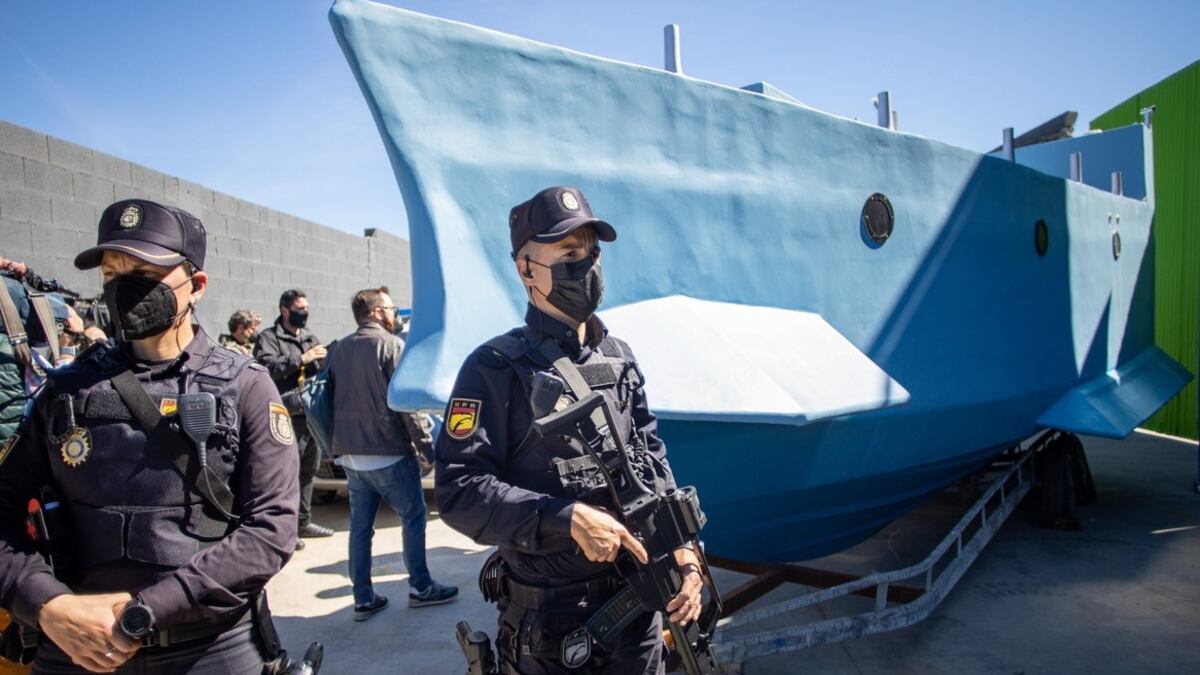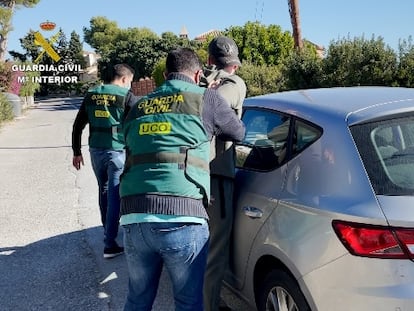The man behind the first semi-submersible narco vessel that was ‘made in Spain’
The boat, initially mistaken for a carnival float, was discovered in a town in Málaga and was designed to transport 2,000 kilos of cocaine
Fidel, whose real name is Gilberto Morales, is also known as “the Boss.” For more than five years, this is how he was referred to in police wiretaps. But it was not until a year ago, when Operation Ferro was launched, that Spain’s National Police began to piece together his long career as a drug trafficker, culminating in the design of the first semi-submersible drug-smuggling vessel to be manufactured in Spain.
A semi-rigid Zodiac with a cabin, the craft was located inside a warehouse in Monda, a town of 2,500 in the southern province of Málaga in the Sierra de Las Nieves mountains. At first glance, officers took the sky-blue boat for a carnival float or a fairground attraction. But on closer inspection, they realized it was an ingenious nautical creation whose main objective was “not to arouse suspicion” while transporting thousands of kilos of cocaine, with its maiden voyage planned for the Strait of Gibraltar.
The boat was designed and made by none other than Fidel, a 55-year-old Cuban who worked for years for notorious Spanish drug lord José Ramón Prado Bugallo, aka “Sito Miñanco.” Like many other drug traffickers, Fidel moved to the south of Spain in 2010 when business dried up on the Galician coasts with the fall of the main drug lords.
He was arrested – not for the first time – last February in his mansion in Marbella, a vast, luxurious villa where, according to a source from the investigation, he had been living for several years with his wife. Fidel also has a son, who was not present at the time of the arrest, according to sources from the investigation.
Meanwhile, a few dozen meters from his villa, his Cuban crony and assistant Marcos, 51, was also being handcuffed in his villa where he lived with his wife and two children.
Two newspaper clippings found in one of the rooms in Marcos’s villa recounted the long journey Fidel and Sito Miñanco had taken together: “A Galician network of drug traffickers has fallen due to a lack of work and moved to the Strait of Gibraltar. Among the 18 arrested is its ringleader, a Cuban resident of Santiago,” says one report, published on May 29, 2010.
We came across the narco vessel behind scaffolding at the back. Even we thought it was a carnival floatSource from investigation
Just over seven years later, on August 3, 2017, the newspaper La Voz de Galicia published a report stating: “The UDYCO [Drugs and Organized Crime Unit] implicates Sito Miñanco in an international drug-trafficking operation led by an organization from Ribeira.”
The “Cuban resident of Santiago” was Fidel; and again it was Fidel who allegedly rented the Seat Toledo in which Sito Miñanco was intercepted by the Civil Guard, on May 4, 2017, at 4am in Queiruga in Porto do Son during a routine stop.
The police suspect that Fidel and Sito collaborated for years in Galicia and that the nautical knowledge of the former was inevitably be applied to the latter’s business. In fact, on one of the occasions Fidel was arrested, police seized a boat that had previously belonged to Sito Miñanco, according to investigators.
No one knows exactly how or where Fidel learned to adapt boats to transport tons of drugs. He may have worked in a shipyard or in a shipping company, though investigators are leaning more toward the theory that he learned his skill from the Colombians who build all kinds of narco vessels in clandestine shipyards in the jungle, such as the narco-submarine intercepted off the coast of Pontevedra, Galicia, in November 2019.
Now the Spanish navy is preparing a study on Fidel’s nautical feat: the first semi-submersible drug boat that was “made in Spain.” Though it never set sail on its maiden voyage, investigators say that everything points that it is apt for sailing.
The vessel measures nine meters long, three across and three deep. On the keel, a source from the investigation describes “a structure of frames and reinforcements made from plywood and fiberglass panels imported from the Netherlands to provide the necessary structural strength.”
The narco vessel must have taken Fidel months of work and cost approximately €1 million, according to investigators
The result, beyond its ingenious appearance, is a vessel with a cabin for two crew members, whose interior is accessed through a hatch in the deck. The cabin has a control console and a wheel for the rudder. Next to it is a bed for one crew member to rest while the other one steers. The cabin provides the only standing space. The rest of the vessel is designed to store packages of drugs, with a capacity of up to 2,000 kilos, according to sources from the investigation.
A source from the investigation adds that the aim of the vessel, which was powered by two 200-horsepower Volvo engines, “was not speed, but to go unnoticed. The idea is that it would lie level with the water, which is why it is that [sky blue] color – to be better camouflaged. But it also has a structure made from poles to transform it into a sort of yacht, if necessary.”
Fidel’s brainchild must have taken him months of work and cost approximately €1 million, according to investigators, who also point out that it was well concealed in the back of an industrial building in Monda, a low-key town with little police surveillance.
“From the outside, the building looked like a wholesale warehouse for grocery products – there was everything from cleaning products to fresh vegetables inside,” says a source from the investigation, who adds that the last thing anyone expected to find was a drug boat when a search was carried out on the premises. “We had that place under surveillance,” says the source. “The day before, they took a shipment of 550 kilos of hashish out in trucks, and when we raided the warehouse at dawn, we came across the narco vessel behind scaffolding at the back. Even we thought it was a carnival float.”
Fidel’s gang was made up of five people, one of whom acted as a link with other Colombian, Portuguese and Dutch organizations with which they collaborated. Along with Fidel and Marcos, 49 others were arrested in Operation Ferro while the unused narco vessel awaits its fate in a judicial warehouse in San Roque, in Cádiz province.
English version by Heather Galloway.
More information










































